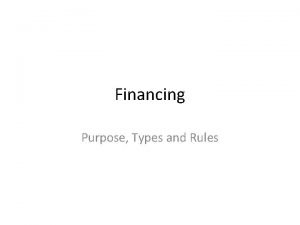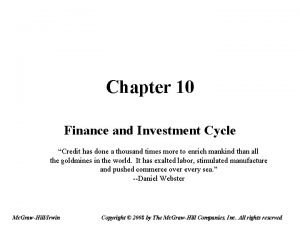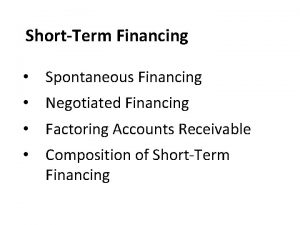Financing Purpose Types and Rules Purpose Purpose Financing











- Slides: 11

Financing Purpose, Types and Rules

Purpose • Purpose: Financing is about obtaining amounts of money in order pay for large-scale (relative to the size of a business) purchases and activities • Generally, this means acquiring funding for assets (equipment, land, buildings) • It is generally not intended for operational expenses (e. g. variable costs) except in the case of start-up or expansion (hence “working capital”)

Types • There are three general types of financing • Cash - i. e. your own or self-financing • Debt - loans and other loan-like instruments where you borrow money from outside parties and promise to re-pay • Equity – sale of an “interest” in your business to outside parties without explicit guarantee of re-payment but implicit expectation of sharing in “returns” i. e. profits of business.

Rules: Pecking Order • • • Pecking Order Theory states that cash is better than debt is better than equity. The order reflects increased “agency” costs, which include tangible costs (e. g. interest and transaction fees) but also intangible costs that accrue from loss of control to outside interests. Cash is “king” because you set the terms and self-financing does not increase outside control Debt is second because it has mostly tangible costs (interest rates and transaction fees). There are some intangible (or relatively intangible) agency costs. Those providing debt financing have to assent to your business plan, or at least proof of ability to re-pay, and may require modifications or limits on your business plan. Specified transaction fees and re-payment schedules impact your cash flow (and even the amount you may need to borrow). Equity is last because it is literally based on giving up a stake of your business – i. e. selling a portion of the control/ownership. The agency costs are virtually all intangible (you are not required to pay a return), but the demands of equity holders can strongly inhibit your (preferred) choices for how the business acts or what it does/does not do.

Rules: Matching Principle • The Matching Principle states that whatever financing mechanism you use it should be “matched” to the useful life of what you are purchasing or the period of purpose (e. g. “working capital”). • This is most obvious with debt to purchase assets. Since the assets are the basis for generating the money to re-pay, you don’t want to take a loan for longer or shorter than their useful life. • Longer and you’re paying for your loan beyond the point that there is cash being generated from the loan to pay for it. • Shorter and you risk having to pay back the loan before you’ve earned the money to re-pay

Putting the Rules together • In general we should try to pick the financing mechanism with the least agency costs and the best match • Large capital expenses with long useful lives/or longer term purposes (e. g. major expansion) may force us “down” the pecking order given limits on own cash • Within types and given matching – choice is based on relative agency costs (tangible and intangible). • Note that not-for-profits are limited to the first two financing options – equity is not feasible as it requires payments to outside agents and is not compatible with mission (e. g. NFPs aren’t in business of generating $$ return). Philanthropy could be considered a form of non-pecuniary equity financing (think donation for name on building).

Some Financing Terms • Transaction Fees – these are the costs of setting up or maintaining a financing option. All external financing has transaction fees on top of interest rate. • Secured/Unsecured – Secured financing is financing “backed up” by some collateral (asset) that the borrower owns. Unsecured financing is based on expected ability of the business to generate sufficient revenues in excess of cost. • Balloon vs. Scheduled Principal: Scheduled financing involves a fixed schedule principal and interest payments. Balloon financing only schedules interest while principal is only due at end of financing term. • Callable: For bank-type loans, these are terms that allow the lender to demand full principal payment prior to the term under certain conditions (“call the loan”). For bonds, these are terms where the underwriter can effectively repurchase the bonds from buyers before term, usually at some premium to redemption value.

Short-Term Financing • Short-term typically means no more than a year • Cash – think cash on hand general cash management – you do this so that you can “loan” yourself money for short -term needs • Transaction or Bank Notes – short-term loans (e. g. 30, 60, 90 day) that are unsecured with balloon principal (and usually interest) payments • Extension of Credit – we can (on agreed terms) wait to pay our bills – which can generate short-term cash but typically has some cost (e. g. 2/10 net 30) • Sale of Current Assets – Accounts receivable (e. g. lagged/uncollected revenues) can be sold at a discount to raise cash – but does risk future cash flow. .

Middle-term Financing • Middle-term is usually 1 to 10 years. • Cash – if you have it. . might include sale of long-term assets not in use (extra/old equipment, land, etc. ) • Bank Term Loans – loans for a specified periods with scheduled principal/interest payments. More likely but not necessarily secured. Typically not callable • Bank Lines of Credit: Agreement to allow borrowing up to a predetermined amount within a specified time period. Typically unsecured with balloon principal payments. Borrowing may be preauthorized to limit (“revolving”) or require bank authorization at point in time (“normal”). Transaction fees can include commitment fees that pay nominal interest on unused balance. More typical to be callable particularly for “revolving” line of credit. • Leasing vs. buying – we will talk about this later in class specifically, but leasing can be a way to minimize agency costs of borrowing…

Long-Term Financing • Long-term is typically 10 -30 years for debt – equity has no “expiration” date. • Cash is very unlikely here… • Bonds – marketable securities (can be bought or sold by individuals) that provide “loan” at fixed interest rate. Typically balloon repayment of principal (but can have “sinking funds” that require principal paid to schedule to escrow) with regular interest payments (coupons). May or may not be secured (revenue vs. mortgage bonds). • Equity - marketable securities that represent ownership (shares) in a business. While like a loan (you sell equity to raise money), equity is entirely unsecured and there is no guarantee of payment or return of any kind (other than par value which is usually 5 cents a share). But return is not limited to any amount (like interest rate) and have voting rights on business activity.

General and Specific Business Applications • Clearly we want to match and stay “up” on the pecking order to minimize tangible and intangible agency costs • Specific agency costs may interrelate – so that needs to be accounted for – a bank term loan might have lower interest or transaction fees than a line of credit – but term loans require borrowing full amount up front and paying principal right away – which could require more borrowing – and thus higher relative agency costs. • This is why I gave us a revolving line of credit (notably with no transaction fees(!)) – it gives us flexibility in borrowing and repayment that minimizes our agency costs. • In general, businesses seek flexible financing with the fewest stipulations and minimum effect on cash flow – e. g. unsecured, balloon payment (or no payment) financing beyond cash – lines of credit, revenue bonds, equity…
 Financing purpose
Financing purpose Gross operating cycle
Gross operating cycle Truth tree logic
Truth tree logic Kelvin rodolfo
Kelvin rodolfo Philippe thiel
Philippe thiel Pros and cons of risk financing
Pros and cons of risk financing Finance and investment cycle
Finance and investment cycle Partial statement of cash flows indirect method
Partial statement of cash flows indirect method Operating investing and financing activities
Operating investing and financing activities Spontaneous short term financing
Spontaneous short term financing Corporate financing and investment decisions
Corporate financing and investment decisions Scotiabank yield more financing
Scotiabank yield more financing




















